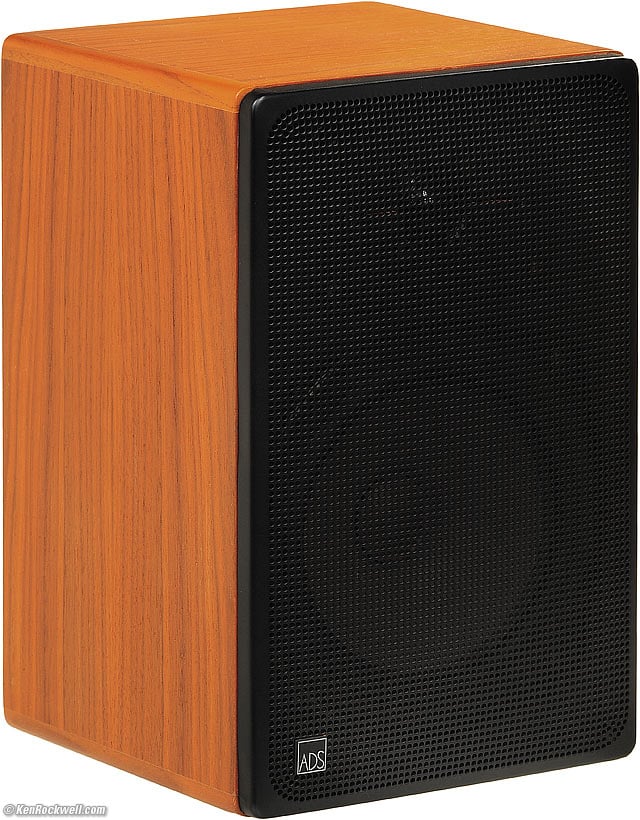Home Donate New Search Gallery Reviews How-To Books Links Workshops About Contact
ADS L400
Miniature Loudspeaker (1983-1986)
© 2011 KenRockwell.com. All rights reserved.
ADS L400 in walnut (12 x 8 x 8," 4.8 kg/10.7 lb. each, 2-way, 7" sealed-box, about $250 used). larger. This free website's biggest source of support is when you use these links, especially this link to ADS speakers at eBay where they sell for about $250 the pair (see How to Win at eBay) when you get anything, regardless of the country in which you live. Thanks! Ken.
October 2011 Audio Reviews All Reviews
|
I use Adorama, Amazon, eBay, Ritz, B&H, Calumet, J&R and ScanCafe. I can't vouch for ads below.
|
Introduction
In its day, this ADS L400 miniature loudspeaker was very good, and very expensive.
The biggest reason to seek out these loudspeakers today is because they are beautiful. See the solid-wood radiused edges? They match almost exactly to Komfort's very expensive Danish dressers and night stands of the same era. While these speakers are walnut, as they have aged over the years, they match Komfort's teak almost exactly in both color and style! The ADS L400 are very handsome loudspeakers.
If you're a fan of Dieter Rams' industrial design (the guy who designed the Braun coffee makers and alarm clocks of the same era), you'll want a pair of these, and they do sound good. New York's Museum of Modern Art is loaded with Dieter Rams' and ADS' work.
While these L400 usually sell for around $250, a really nice pair as seen here will sell for more like $400 used today. The price is high because of their looks and lineage; if sound quality is your only concern, you'll probably prefer something else like the similarly priced and sized B&W CDM2.
This ADS L400 sounds very good, but other much more serious small speakers like the B&W Matrix 805 outdistance it in clarity, depth, output and low-end output. I haven't compared it to modern new speakers like the Mackie desktop powered monitors which sell for about the same price, brand-new.
These small ADS speakers aren't intended to play loudly. Rated for a maximum of 75 Watts, they have a light-duty woofer designed for quality rather than quantity. I'd avoid trying to blast these at full-level, full-range. These were designed originally to be used as part of a Sub-Sat system and not be driven with the lowest frequencies if played loudly.
These work great as part of a desktop system, especially with two pairs of the tiny AudioEngine stands. When used close or at low levels, equalizing the lowest frequencies for full-range use works well to give much deeper bass than you'd expect. The +3 and +6 dB positions of the Quad 34's BASS LIFT control do this rather well.
The particle-board cabinets are finished so precisely that they look as good as if they were made in Denmark, but they're Made in USA, better than American furniture of the same era. The inside is filled with Fiberglas, and oddly, the insides are finished in fake vinyl oak-grain!
As expected for an unreinforced cabinet, there is some cabinet vibration with music. Because they are small, they sound pretty solid when tapped — but not as solid as as a B&W CDM1 SE and certainly nothing like tapping the cabinet of a B&W Matrix 805.
For you photographers, there is a 1/4" - 20 tripod socket on the bottom!
Internal wiring uses little push-on clips.
The beautiful perforated metal grills float over the front of the speaker. I'm unsure how they are really supposed to stay attached. The front face of the speaker has concave corners that come forward to hold the grille, and they could add to reflections.
Rear, ADS L400 in walnut. larger.
The rear terminals are made-in-Taiwan push connectors.
There is a hole on the top rear, presumably for wall-mounting.
Sound
The ADS L400 is what we expect from a New England paper-coned, dome-tweetered sealed speaker: smooth, uncolored sound. The ADS L400 has the fabled polite New England sound: nothing is emphasized.
The highs are sweet. The very high treble might be just a tiny bit stronger than usual, giving cymbal ticks a nice presence. The ADS L400 doesn't emphasize anything; any errors would be errors of omission.
The L400 is never, ever harsh. It's always smooth.
The L400 isn't very sensitive; even rated at only 4 Ω, the L400 has less voltage sensitivity than the 8 Ω B&W CDM1 SE. The L400 trades sensitivity for low-end extension and tiny size.
The ADS L400 are very accurate. The L400 isn't particularly sensitive to vertical listening angle.
The L400's main sonic defects are those typical of any speaker in a box: sound obscured by short-term internal reflections. Sounds from the backs of every driver have to go somewhere, and some make it out through cabinet walls. Casual listeners of pop music would probably never notice, but when you expect to be able to hear the actual sound of the concert hall, it's more muddy.
To more casual listeners, these less controlled back-of-driver sounds lead the L400 to lack the depth of image had by better speakers. With the L400, I can't hear back past the ensemble to the inky black background of the concert hall as I can with better speakers like the B&W Matrix 805.
The bass is what you'd expect from a large small speaker. If you hit it too hard, you get doubling (distortion). Sweeping the bass with sine waves, the last peak is at 100 Hz, and that's it for unreinforced bass response.
What bass there is is tight and light. It sounds little without equalization, but it doesn't have any boom either, which is good.
ADS L400 in walnut, grill lifted. larger.
Perspective and Specifications
Gray text refers to models not reviewed here.
1970s
ADS made a completely different model L400 in the late 1970s.
It was also two-way sealed-box with a 7" woofer and 1" dome tweeter, but it was bigger and uglier.
1980
ADS introduced a model 400 (Christmas special: no "L") in the fall of 1980 as a "larger miniature loudspeaker" as part of its first SubSat 2300 Powered Bass/Satellite system.
In this system, the model 400 was used on F400 floor stands, along with a dedicated PB-1500 Powered Bass Module (subwoofer).
The PB-1500 had two 10" woofers, 200 W of amplifiers.
A C-1500 Bass System Control was both the low-level active crossover as well as some low-end processing cleverness for the PB-1500.
The point of the larger model 400 speaker was a speaker which covered down to 100 Hz very well for very serious listening, and then letting the larger subwoofer handle the very low frequencies. ADS' L300 and smaller speakers couldn't really handle 100 Hz effortlessly, and crossing over any higher than 100 Hz to a mono subwoofer was a bad idea since you are in mono below the crossover frequency.
The earlier model 400's specs are:
7" "Stifflite" (cardboard) woofer.
65-20,000 Hz ± 3 dB.
6 Ω nominal, 4 Ω minimum
93 dB SPL @ 2.8 V RMS @ 1 meter, but in a "typical" 2,000 cubic foot room. This spec was a crock; the "typical room" adds quite a few extra dB!
12 dB/octave crossover at 1,500 Hz.
Power handling 50W nominal, 75 W maximum.
Suggested amplifier power: 15 W - 75 W.
11-3/4 x 7-5/8 x 6-7/8 inches HWD.
Walnut or Oak veneer over extra high-density particle board with solid-wood corner inserts.
Perforated metal grill.
9 pounds each.
$359 catalog price per pair in 1980, $379.90 in 1981. ADS speakers rarely sold at discount.
In 1982, ADS up-specified them as 60-20,000 Hz ± 3 dB, 5 W minimum amplifier power, and listed them at $399 the pair.
1983-1986 (Reviewed here)
Exterior Design: Dieter Rams.
This new model L400 is introduced.
7" paper "Stifflite" paper woofer, rubber surround, stamped steel basket.
1" dome tweeter part number 206-0116. Measures 3.95 Ω DC.
60-20,000 Hz ± 3 dB.
90 dB SPL (conditions unspecified)
10 W minimum amplifier power.
2 kHz crossover
4 Ω nominal, 3.2 Ω minimum.
11-3/4 x 7-5/8 x 7-3/4 inches HWD specified, (rounded to 12 x 8 x 8" 1984-1986.
11-3/4 x 7-5/8 x 8" HWD, measured, including grille.
22 pounds per pair specified.
I measure 4,790g (10.74 pounds) for this sample.
1983-1985: $399 the pair.
In 1984, the Oak and Walnut models are each given their own model numbers, L400-W and L400-O.
1986: $420 per pair.
1987-1989
ADS made nothing called L400.
1990
ADS introduced a new L400e, pres8mablun in a metal cabinet.
60-20,000 Hz ± 3 dB.
88 dB SPL, conditions unspecified.
35 W minimum amplifier power.
2 kHz crossover.
12 x 8 x 8 inches HWD.
19 pounds per pair.
Here's the kicker: catalog price is now $650 per pair in 1990 and 1991.
Catalog price drops to $599 per pair in 1992-1994, specified as 9.5 pounds each.
In 1994, they are now specified as 8 Ω, 90 dB SPL, 10 W minimum, 13 pounds each and 60-23,000 Hz ± 3 dB, still at $599/pair catalog price.
Measurements
Impedance
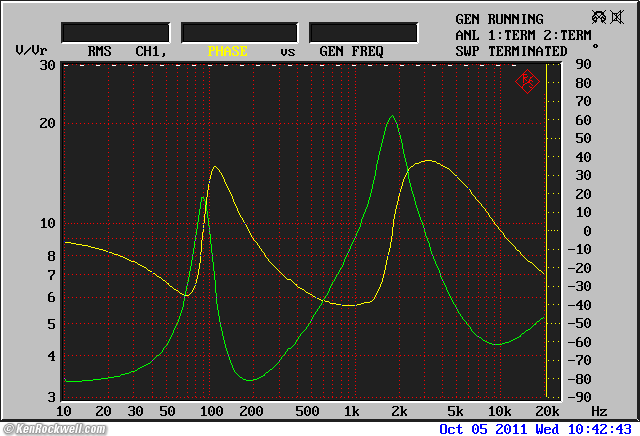
ADS L400 Impedance magnitude (Ω), and phase angle versus frequency. (R&S UPL; +90º is capacitive, -90º is inductive.)
Yes, it's really 4 Ω nominal and 3.4 Ω minimum. It's resistive at the lowest impedances, so good times.
Frequency Response
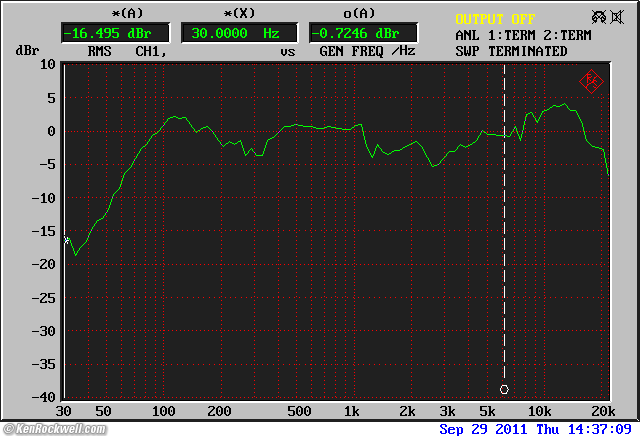
ADS L400 Frequency Response (half-space anechoic at 0.3 meters).
Gotcha! The nice, slightly strong highs I heard are a slight boost at about 13 kHz with no other particular peaks. Likewise, the slight dip at 3 kHz gives the L400 its polite, non-harsh sound.
Ignore the blip at 20 Hz, that's ambient noise in my anechoic environment.
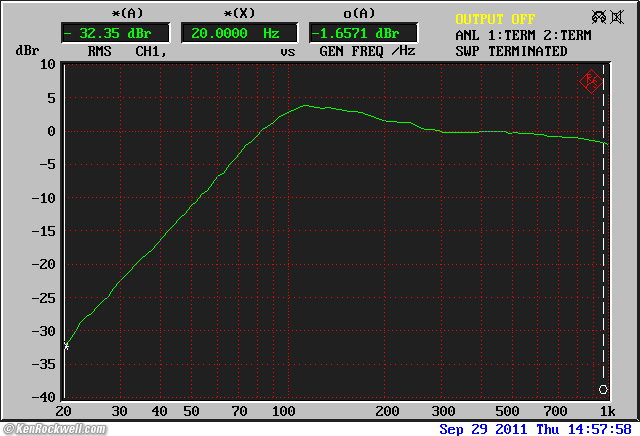
Detail, ADS L400 Low-Frequency Response (half-space anechoic).
This detail is for you folks designing active equalizers or crossovers. I'm unsure why it looks like 15dB/octave instead of 12 dB/octave, but tough, this is a free website!
Distortion
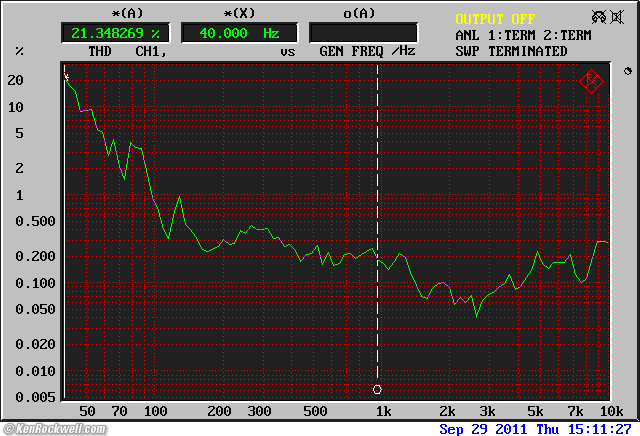
ADS L400 Distortion versus frequency, 100 mW input. (0.63V RMS at 4 Ω)
This is very, very nice: less than 0.5% THD at all non-bass frequencies. My anechoic space isn't quiet enough to measure the THD of the weak low frequencies; the high readings are more ambient noise than speaker distortion.
Tone Bursts
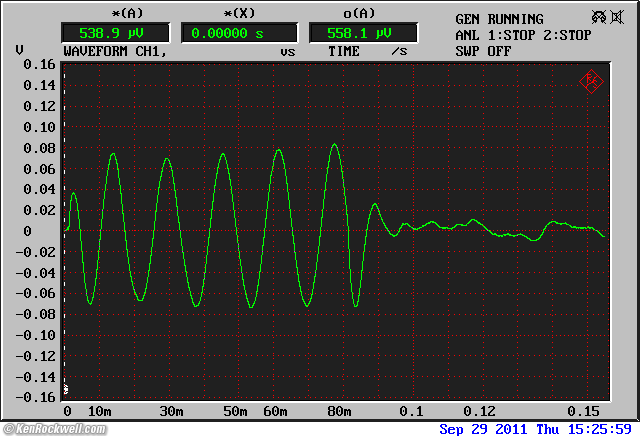
Response to 62.5 Hz 5-Cycle Tone Burst, ADS L400 (0.3 m).
Nice! Near waveform-fidelity at 62.5 Hz.
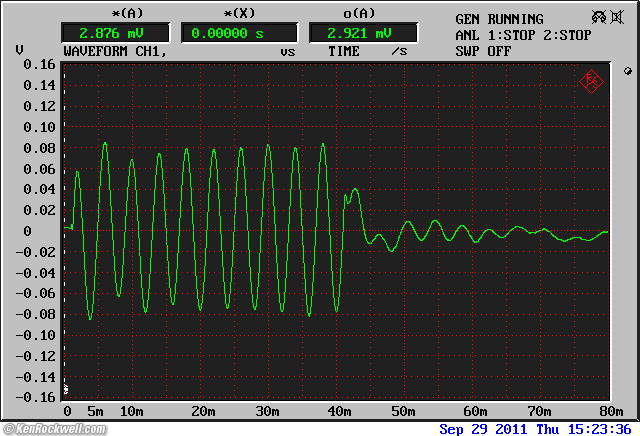
Response to 250 Hz 10-Cycle Tone Burst, ADS L400 (0.3 m).
Gotcha! See the residual ringing at 250 Hz? That's the veiling I was hearing: sounds go from the back of the woofer, and they don't simply disappear inside the box as they do in fairy-tales.
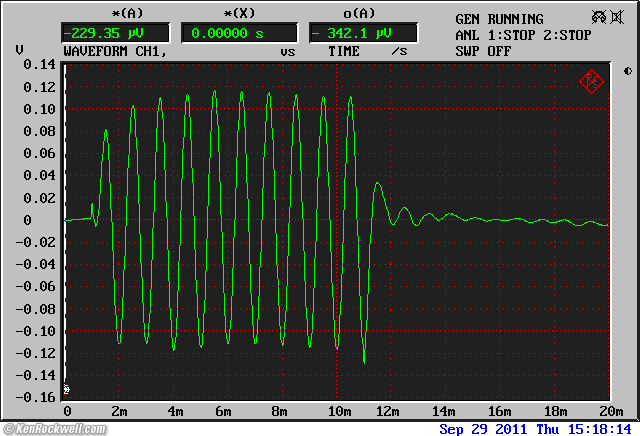
Response to 1 kHz 10-Cycle Tone Burst, ADS L400 (0.3 m).
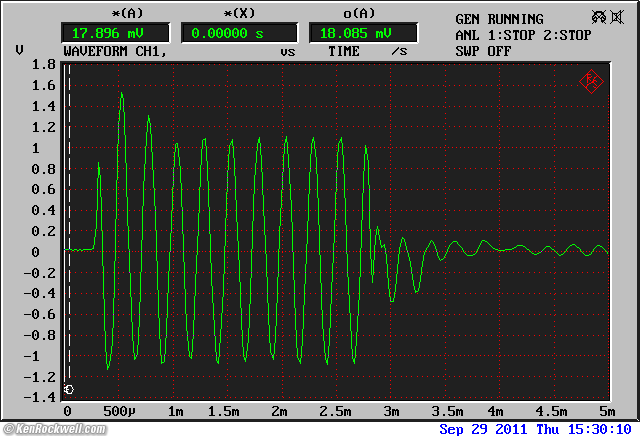
Response to 4 kHz 10-Cycle Tone Burst, ADS L400 (0.1 m).
Summary and Recommendations
Get these for your desk or home if you love the look of Germany's finest industrial designers. These work very well with stereo subwoofers and a proper stereo subwoofer crossover.
I wouldn't hit them with too much power; keep it soft and these sound great.
Help me help you top
I support my growing family through this website, as crazy as it might seem.
The biggest help is when you use any of these links to Adorama, Amazon, eBay, Ritz, Calumet, J&R and ScanCafe when you get anything, regardless of the country in which you live. It costs you nothing, and is this site's, and thus my family's, biggest source of support. These places have the best prices and service, which is why I've used them since before this website existed. I recommend them all personally.
If you find this page as helpful as a book you might have had to buy or a workshop you may have had to take, feel free to help me continue helping everyone.
If you've gotten your gear through one of my links or helped otherwise, you're family. It's great people like you who allow me to keep adding to this site full-time. Thanks!
If you haven't helped yet, please do, and consider helping me with a gift of $5.00.
As this page is copyrighted and formally registered, it is unlawful to make copies, especially in the form of printouts for personal use. If you wish to make a printout for personal use, you are granted one-time permission only if you PayPal me $5.00 per printout or part thereof. Thank you!
Thanks for reading!
Mr. & Mrs. Ken Rockwell, Ryan and Katie.
Home Donate New Search Gallery Reviews How-To Books Links Workshops About Contact

